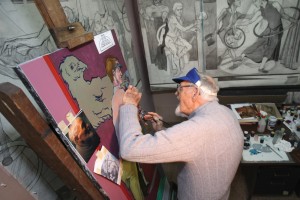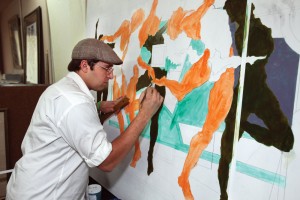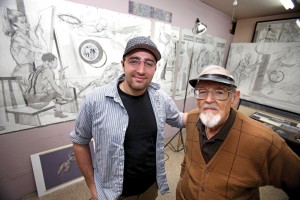Colorado College alumni Eric Bransby ’47 and Trevor Thomas ’10 help bring an art form from the edge to a comeback.
Reprinted with permission from the Colorado Springs Independent.
It’s happened slowly and quietly, but the Colorado Springs Fine Arts Center has pushed an art form on the edge toward a major comeback.
Murals — not the kind you see under a bridge, but commissioned pieces executed by artists — have all but disappeared from many public places. In an age when cost-effectiveness dominates construction and mass appeal in art is deemed an abject goal, murals have come to appear as both unnecessarily extravagant, and more decorative than artistic. They took another hit when spontaneity became the preferred tone in 20th-century artwork; a mural is anything but a spontaneous undertaking.
Nevertheless, the FAC has chosen to honor its 75th anniversary, in large part, with murals. The large upstairs gallery will host Boardman Robinson’s The History of Commerce series; the 10-mural collection by former FAC school head and instructor Boardman Robinson hasn’t hung in its entirety for nearly 50 years.
These portable murals will join a host of others permanently affixed to the FAC’s walls, including ones in the courtyard, on the front facade, and in Amuzé at the FAC. Also, the FAC has commissioned a mural depicting its history and mission from local artist Eric Bransby.
The new work, tentatively aimed for unveiling at the end of the summer, will stretch 30 feet across the grand hallway atop the donors wall. Not only was Bransby a good choice, he was the FAC’s only choice, says executive director and CEO Sam Gappmayer, who adds, “It was just such a logical place to go for this commission.”
That’s because Bransby, 94, not only specializes in murals — throughout his seven-decade career, he’s painted murals in universities and museums throughout the country — he has also lived much of the FAC’s history. Bransby was a student of the FAC’s fine art school, and a pupil of Robinson’s.
Backward glance
Boardman Robinson came to Colorado Springs in 1930, having already established himself as a renowned muralist and well-respected political cartoonist. He began teaching at Fountain Valley School, then transferred to the Broadmoor Art Academy (the FAC’s early incarnation) in 1931. By 1936 he was the leader of the FAC’s art school, guiding it to become one of the nation’s most respected art schools at that time.
Robinson helped christen the FAC’s new 1936 structure by painting five murals on the front façade. They featured the FAC’s multidisciplinary mission, highlighting music, theater, art instruction, and museum aspects. The year before Robinson arrived in Colorado Springs, he’d completed a commission to paint 10 murals for Kaufmann’s Department Store in Pittsburgh. (The store owner, Edgar Kaufmann, is best known for commissioning Frank Lloyd Wright to build him a home: the result was Wright’s masterpiece Fallingwater.)
The murals, each measuring about 8 by 15 feet, depict scenes of trade and business through the ages, thus the name The History of Commerce. The works begin with the Persians and Arabs, then progress to the Venetians, the Dutch, slave traders in the Americas, and finally an industrialized city scene of the 20th century. A 1929 Time magazine article documents the unveiling of nine of the murals, executed on canvas using car paint, in Manhattan.
 Of the style, the article notes, “There are no pretty girls, no idealization, no gold leaf.” The murals indeed seem almost drab, despite their impressive size and pleasing compositions. They lack an outward sense of drama or a challenging visual presence. But only because that was not their purpose.
Of the style, the article notes, “There are no pretty girls, no idealization, no gold leaf.” The murals indeed seem almost drab, despite their impressive size and pleasing compositions. They lack an outward sense of drama or a challenging visual presence. But only because that was not their purpose.
“There’s nothing ambiguous about it, because these were meant to be experienced by the widest spectrum of the public possible,” says Blake Milteer, FAC museum director and curator of American art. “These were truly meant to communicate, so the painting style had to be simple and yet, sort of classic in its representation.”
This simple approach was popular in its day, though sometimes erring on a more dramatic side. Robinson, along with friend and fellow artist Thomas Hart Benton (of whom Bransby was also a student), were the leaders in establishing a movement of murals in America, later galvanized by Works Progress Administration projects during the Great Depression.
As for the Commerce murals, they eventually followed Robinson to the FAC. They were taken down from the department store in the ‘50s and stored in a warehouse until the FAC accessioned a portion in 1993. The center acquired the rest in 1996 for an exhibit in which eight were put on display. After a few murals spent a brief time at Colorado College, the FAC took them all back last summer. “So, in essence, the 10 of these have not been exhibited together since the late ‘50s in the department store,” says Milteer.
Full circle
Bransby’s connections within the old muralist community are impressive. Aside from his tutelage with Robinson and Benton, he also worked under Jean Charlot. Charlot was an artist who worked closely with Diego Rivera, a longtime friend, and other Mexican muralists. In 1947, Charlot came to the FAC to take over as leader of the school when Robinson fell ill. He stayed for only a few years but helped Bransby finish his thesis: painting the domed ceiling of Colorado College’s Cossitt Hall.
 Trevor Thomas, a 23-year-old artist and recent CC grad who is helping Bransby with the new FAC mural, says that he feels Charlot helped Bransby define his sense of composition. For a mural, that’s one of the biggest challenges, especially in the case of this FAC mural, which means cramming nearly 100 years of history into a limited space, and successfully integrating elements of theater, dance, music, art instruction, and exhibitions.
Trevor Thomas, a 23-year-old artist and recent CC grad who is helping Bransby with the new FAC mural, says that he feels Charlot helped Bransby define his sense of composition. For a mural, that’s one of the biggest challenges, especially in the case of this FAC mural, which means cramming nearly 100 years of history into a limited space, and successfully integrating elements of theater, dance, music, art instruction, and exhibitions.
Framed by a violinist and a saxophone player, the interior panels will depict students in a life drawing class, a scene from Hamlet, the dancer Martha Graham, and figures including Robinson and Lawrence Barrett, one of the top printmakers in his day, who led the school’s lithography program from the ’30s to the ’50s. And since the mural will be painted on masonite boards traced from the original drawings, all the compositional elements must be decided ahead of time. That’s why all seven panels are mounted in Bransby’s studio in the form of full-size drawings.
“So we don’t have to work them out when we get to the wall itself. ‘Cause God knows we have other problems then,” Bransby says with a chuckle. Those problems are one of the other reasons murals are less popular these days, because they require laborious amounts of work to construct. Not the type of project a man in his 90s should take on. But Bransby adores the medium.
“Murals, in general, as a serious art form, have been out of favor for a while,” he says. “But I just kept painting them, regardless. It’s either a case of stupidity or a case of somebody who’s really locked on to the art form.”
Yet Bransby has a hunch that murals are coming back. “We’ve been without ornament in architecture for a long time, and I think people are hungry for it,” he says. “They’re hungry for stuff that tells the history.”
The best proof is standing in his studio in the next generation. Thomas’ devotion to the tradition of the murals is evident in the fact that he has worked full time since last November helping finish the mural. Judging from the FAC’s planning however, it seems that murals have already been rediscovered, if they were ever gone to begin with.
“Art goes in cycles,” Bransby says, “They’ll suddenly rediscover it; it’ll be brand-new.”

One Response to Writing on the Wall
I was born in Colorado Springs at Penrose as was my mother. My grandparents on both sides lived in the Springs. My grandfather was a very well respected ENT doctor. When he passed away I was given 2 framed drawings of Boardman Robinson’s. Both were done in 1933, one is of an early Central City and the other is of a school in the Springs.
Just thought it was interesting. I just discovered who drew them.
Comments are closed.